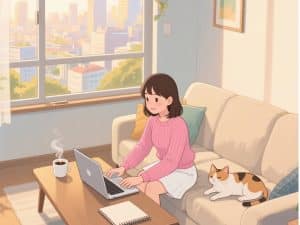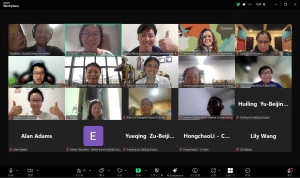The “Inner Drive – Indigenous Art Therapy Exhibition” opened its doors at the TNT Contemporary Art Space in Dafen, Shenzhen on Oct 20, 2023, ushering in a powerful celebration of art’s transformative potential in the realm of mental health. An array of attendees, including indigenous artists, their families, individuals on the path to rehabilitation, psychology professionals, art enthusiasts, and researchers, convened for the event. Beyond the art, the symposium held following the exhibition’s opening ceremony offered a vital platform for insightful discussions on the intersection of art, mental health, and disability rights.
Expressive art therapy and indigenous art
The seminar commenced by emphasizing the indispensable role of expressive art therapy in promoting emotional healing and self-expression. Hu Lijun, deputy director of the Shenzhen Psychological Counseling Industry Association, passionately conveyed the pivotal role of this therapy. It became evident that expressive art therapy, when paired with the richness of indigenous art, emerged as a profoundly transformative medium for self-improvement and self-realization, particularly for artists dealing with mental disorders.
Guo Haiping, the exhibition’s curator, elaborated on the significance of indigenous art as a therapeutic tool and its profound potential for integration with psychology. Importantly, it was underscored that indigenous art’s authenticity, driven by a powerful inner drive, offers not only personal healing but a powerful narrative for advocating mental health and disability rights.
Indigenous art institutions and social responsibility
The symposium placed a spotlight on the vital role of indigenous art institutions. Feng Jianmei, the generous provider of the exhibition venue, illuminated how art fundamentally resides in human emotional expression. She underscored the authenticity, goodness, and beauty that indigenous art brings to light and encouraged attendees to explore the social responsibility of psychological industry associations and grassroots organizations in contributing positively to society.
In this context, indigenous art institutions emerged as significant actors in advocating for disability rights. Art, as a form of communication that transcends words, has the power to amplify the voices of those with disabilities, fostering a society where everyone is valued and given equal opportunities.
A journey of support and empowerment
Wang Jihong, the visionary founder of Shenzhen Neixiang Indigenous Art Studio, offered an engaging narrative of the exhibition’s origins. Gratitude flowed for the unwavering support they received from those who shared their passion for life and art. This journey, marked by challenges and triumphs, stood as an inspiring testament to the power of community, support, and an unwavering inner drive.
The connection between art therapy and disability rights was illuminated by this journey. Art therapy stands as a bridge to empowerment for individuals with disabilities, allowing them to express their unique perspectives and experiences. This empowerment, when celebrated and advocated, advances the cause of disability rights and inclusion.
Dialogue with professionals
The symposium constituted a congregation of esteemed experts from diverse corners of the psychology world, including expressive art therapy, family therapy, rehabilitation psychology, positive psychology, psychosomatic balance, and postmodern narrative dialogues. These experts engaged in profound conversations that fostered new insights, connections, and holistic perspectives on mental health, disability rights, and well-being.
Support and healing
Amidst the dialogue, it became abundantly clear that the lens of perception and awareness plays a central role in artistic expression. A safe space for self-expression emerged as a common denominator for individuals in their quest to delve into the labyrinth of emotions, gaining a deeper understanding of themselves.
The healing power of art therapy took on a broader dimension, aligning with disability rights. Individuals with disabilities found in art therapy a means to communicate their unique experiences and challenges, promoting understanding and empathy within society.
Positive psychology and trust
In a notable shift, the spotlight turned towards the realm of positive psychology. Deng Fa, an authority on the subject, underscored its centrality in the therapeutic process. Trust, trust in the innate power of healing that resides within every individual, and belief in their intrinsic capabilities was held as a cornerstone for meaningful communication. This foundation, grounded in positive psychology, offers a fertile ground for fostering opportunities for self-expression, particularly for those with disabilities.
Embracing individuality
Hu Changbo, a former rehabilitation patient, took to the stage and shared a deeply personal journey. He highlighted the significance of support from families, society, and government in the process of recovery and reintegration. Indigenous art, in his words, emerged as a remarkable catalyst in helping individuals regain self-worth and find their place in society. His poignant narrative underscored the importance of understanding and cooperation between society and government in championing disability rights.
Transformative art therapy for disability rights
Another rehabilitated individual, Hu Qing, took the audience through his transformative journey. His story resonated profoundly, revealing how art therapy had a profound impact on his life. He placed emphasis on the unique gifts that individuals dealing with mental disorders bring to the world and their potential to evolve into valuable members of society, given the right interaction and support.
Hu Qing passionately called for greater societal assistance to ensure that more individuals, particularly those with disabilities, can access the transformative power of art. His heartfelt plea resonated with many in the audience and once again shed light on the essential role of art therapy in the broader landscape of mental health and disability rights.
The symposium concluded with interactions between attendees and indigenous artists. These artists, through their experiences and aspirations, showcased the therapeutic potential of art-making, further underscoring its role in promoting disability rights. Their stories stood as a testament to the healing power of art, the importance of self-expression, and the potential for individuals with disabilities to find their place in society.
In summation, the “Inner Drive – Indigenous Art Therapy Exhibition” seminar profoundly and vividly illustrated the transformative role of indigenous art in the sphere of mental health, disability rights, and well-being. It celebrated the healing power of art therapy and reiterated the pressing need for greater support, understanding, and cooperation to empower individuals dealing with mental disorders and disabilities. Ultimately, this event underscored the profound and positive impact that art can wield in the realm of mental health, disability rights, and well-being, showcasing the potential of art therapy to foster connections, promote healing, and nurture a brighter future for all.



